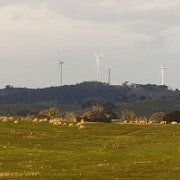8 years of growth in wind power in Australia
How has the performance of wind power trended over the past eight years since it began being installed in earnest?
1) Wind Farm energy output steadily increasing
Using NEM-Review, we generated the following trend – with data aggregated on a monthly basis to make the trend a little clearer (click chart to enlarge):
Taking the data and generating a 12-month rolling aggregate, it becomes clearer that the annual output from wind farms across the NEM has been trending upwards and reached its highest point yet in the 12 months finishing July 31, 2013 (click chart to enlarge):
Taking into account the 'DEMAND_AND_NONSCHEDGEN' data from AEMO (which, we believe, is the best data set equating to what AEMO terms 'Operational Demand'*) and comparing with the rolling annual wind farm output (NEM-wide) we produce the following trend (click chart to enlarge):
As can be seen, the percentage supplied by wind has risen steadily to be at 3.5 per cent currently – but there remains (and appears to be growing) a significant variability in the percentage supplied on a daily basis.
We’ve chosen not to show this ratio on a regional basis as, in our view, that would be a vanity metric and not one that serves as useful a purpose as looking market-wide.
3) But remaining intermittency, despite broader spread of installations
Next, we extended the seven-month-long daily production trend shown in this recent post to span the full range for which data is available and in the following chart it is clear that, while the peak daily outputs have increased considerably over the past eight years, there are still a significant number of times when the market is becalmed.
This chart confirms that it was only on July 4, 2013 that the total energy generated from wind exceeded 50,000MWh for the first (and, to date, only) time across the NEM. We can see that the volume generated has progressively increased (year-on-year).
The noise in the above plot is highlighted on a monthly basis in the following distribution curve generated from NEM-Review (click chart to enlarge):
As shown in this trended distribution curve, despite the fact that the energy generated by wind farms across the NEM has continued to grow over time, the incidence of time when wind output falls to very low levels has not significantly declined over the past four years.
This is despite the fact that wind farms were introduced to southern NSW in mid 2009 (i.e. so the theory is that different weather patterns would mean they’d be producing when wind farms in South Australia were not).
Paul McArdle is the managing director of Global-Roam Pty Ltd, a business that provides computer software that helps users to analyse and understand energy markets.
Originally published by WattClarity. Republished with permission.





















